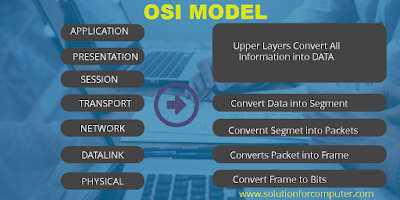Introduction :- OSI/ Open System Interface – The OSI reference model describes how information from a software application in one computers moves through a network medium to a software application in another computer. This OSI Model was developed by the INTERNATIONAL ORIGINATION for STANDARDIZATION (ISO) in 1994, and it is now considered the primary architectural model for inter-computer communication . A task or group of task is then assigned to each of the seven OSI layers.Each Layers is reasonable self contained, so that task assign to each layer can be implemented independently.
Total Seven Layers of The OSI Reference Model
6. Presentation Layer :- The Presentation Layer entities can use different syntax and semantic as long as the presentation service understand both and the mapping between them.The presentation service data units are then encapsulated into session protocol data units and moved down the stack.
7. Application Layer :- The application layer interface directly to end process common application service for the application process . It also issues requests to the presentation layer. Note carefully that this layer provides service to user define application process and not to the end user.
OSI Model Layer and Protocol
1. Physical :- NIC, Twisted Pair , Fiber Optical , Wireless media, Repeater, Hubs , etc.
2. Data Link :- Ethernet, Token ring , LAN , Wi/Fi, Router etc.
3. Network :- Internet Protocol, ICMP, RIP , etc
4. Transport :- TCP , UDP, RTP, ATP.
5. Session :- TLS , SSH, RPC,
6. Presentation :- SMB, NCP, HTML
7. Application : Web Browser., Email, Print Service, SIP, NFS,
this post is useful for you and you like this post please share this
post with your friend on Facebook, twitter, Google plus and more
.Please comment your experience about this post in comment box , and
you also follow us by email and other social media .




wow great information thanks for that you doing good work. keep it up.
wow great information thanks for that you doing good work. keep it up.